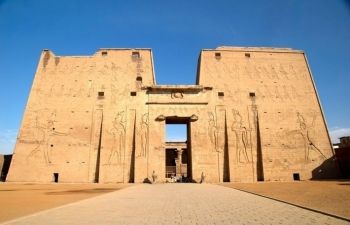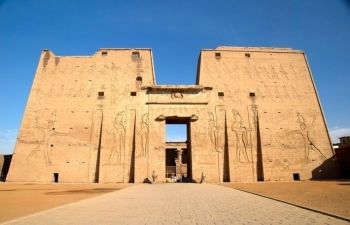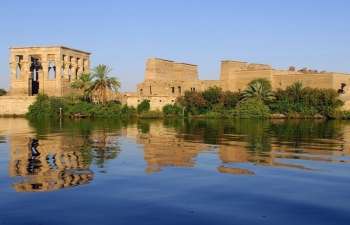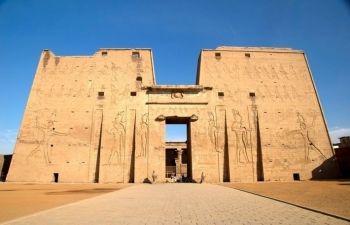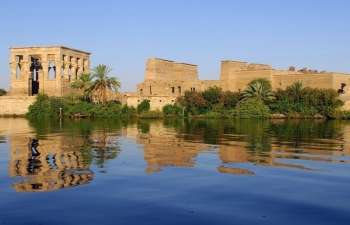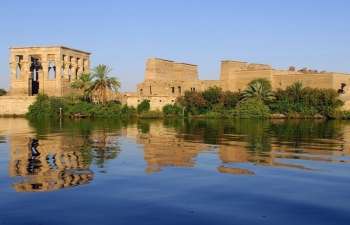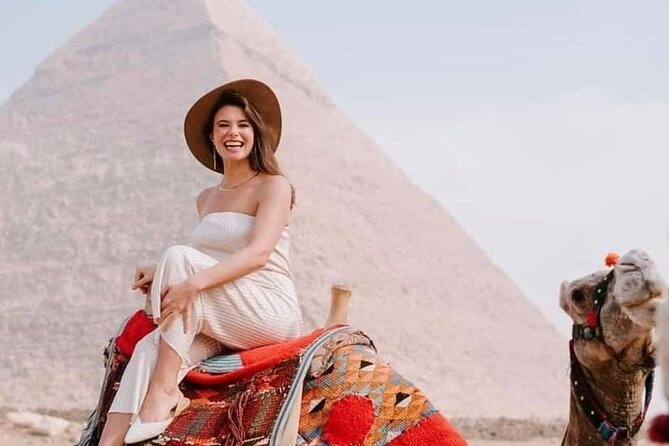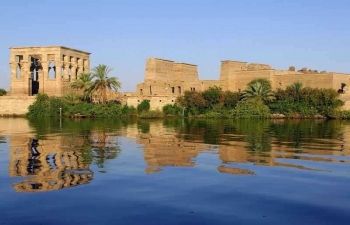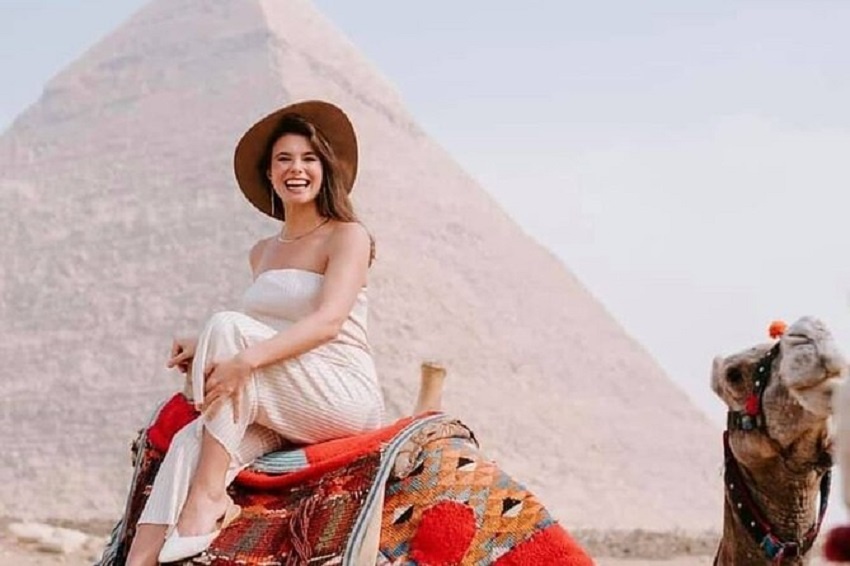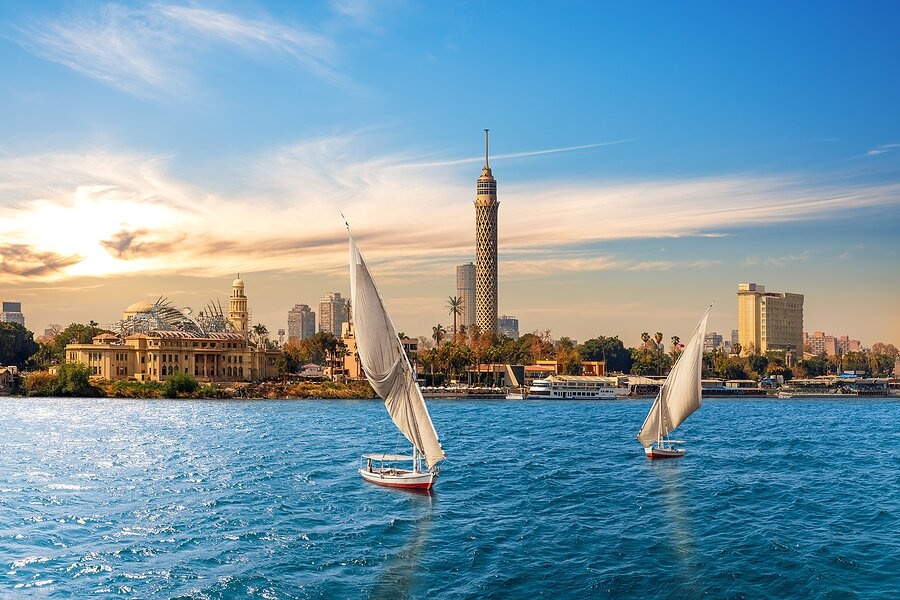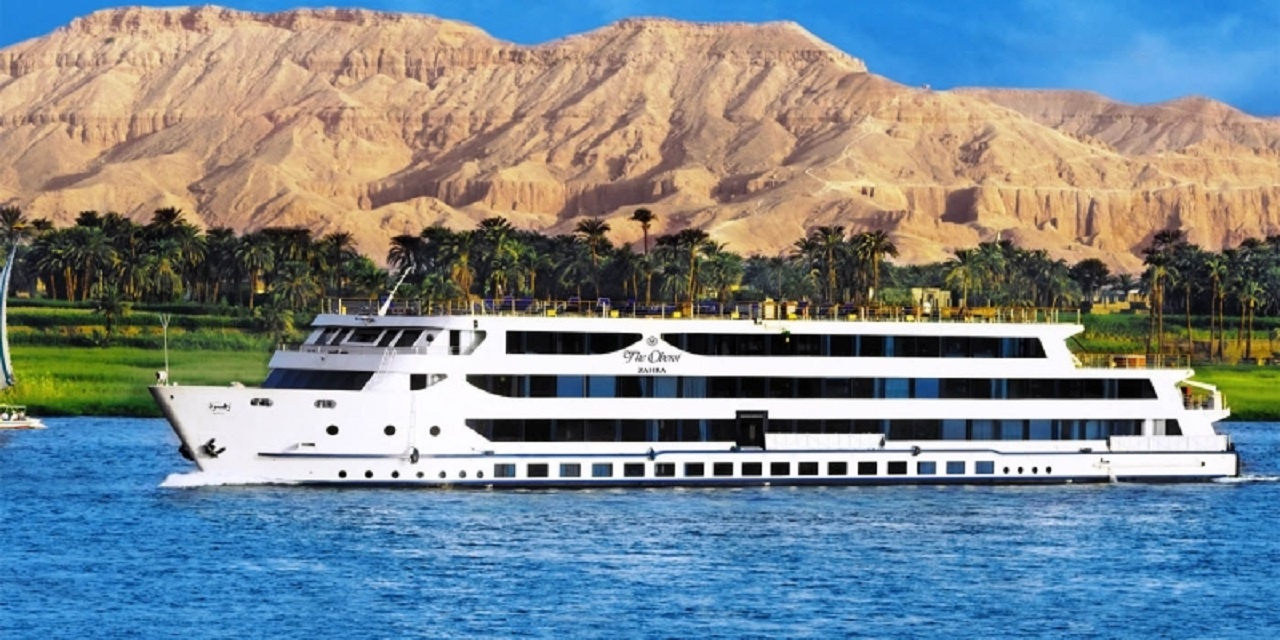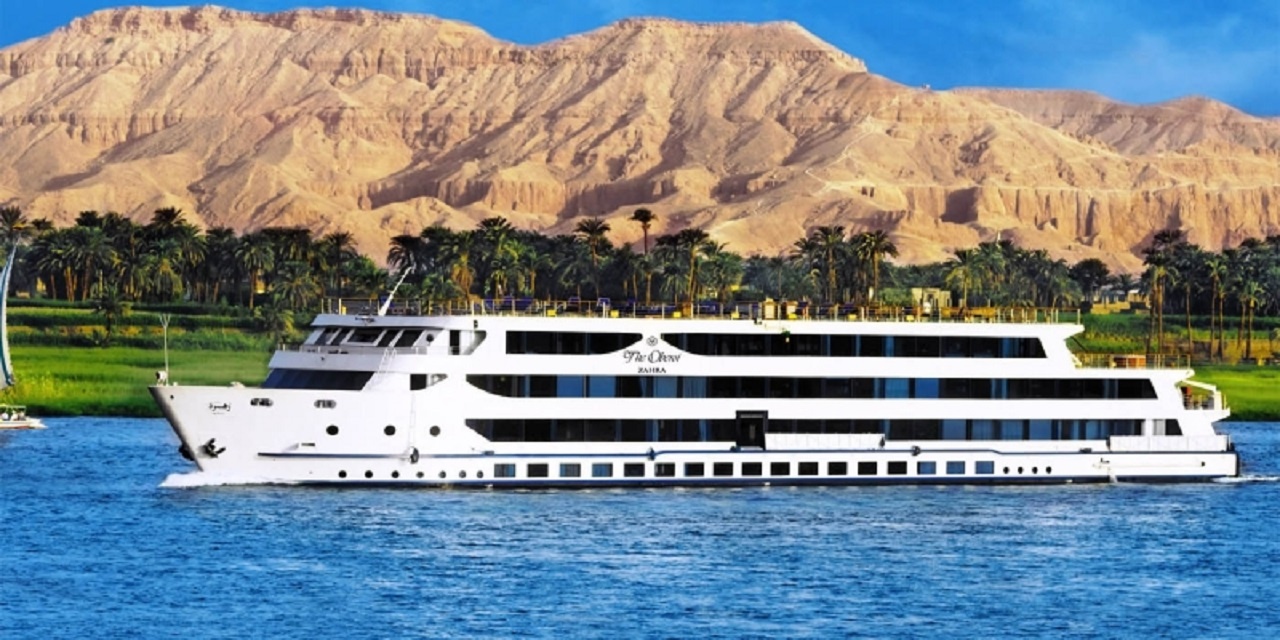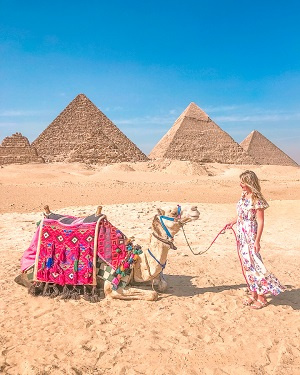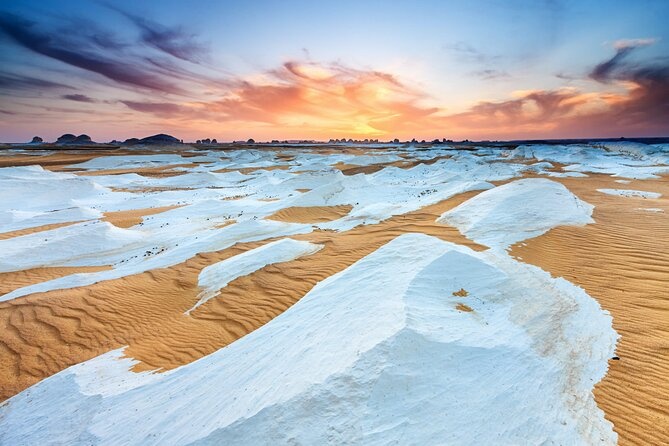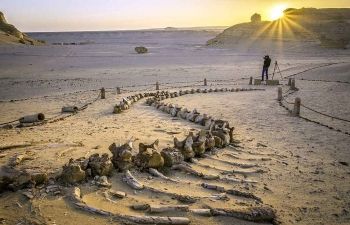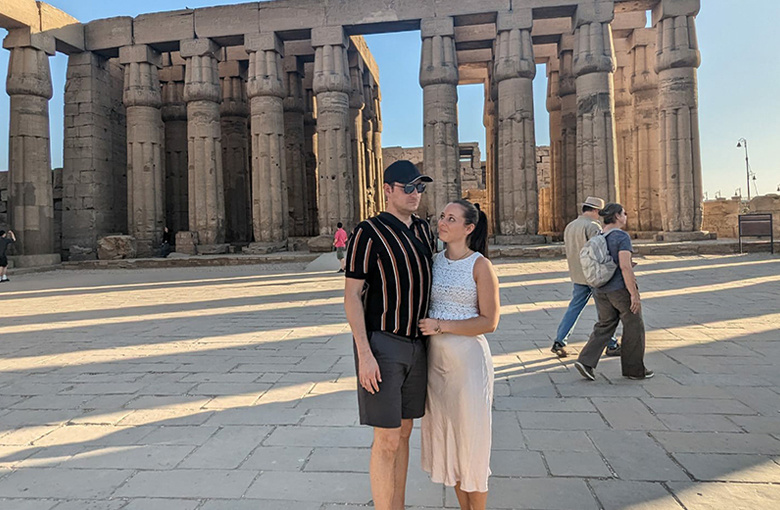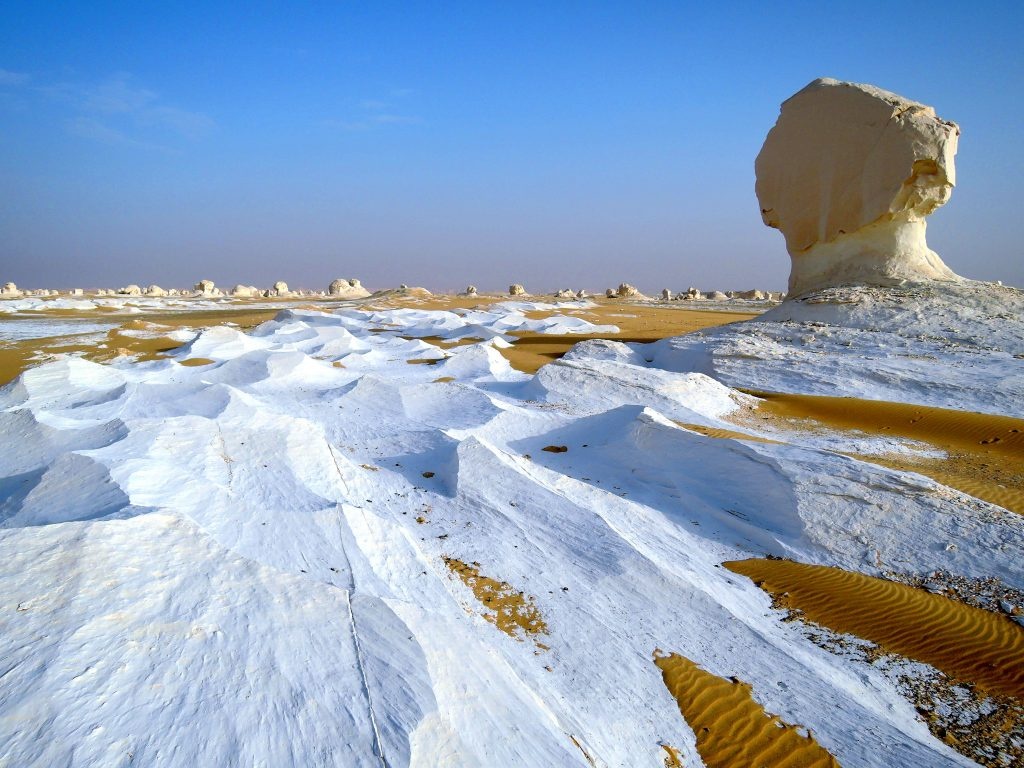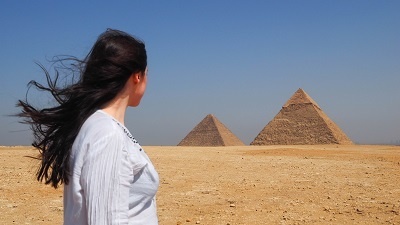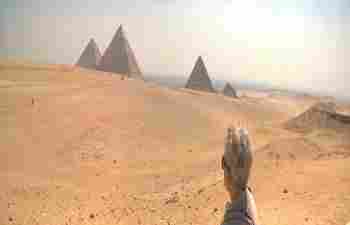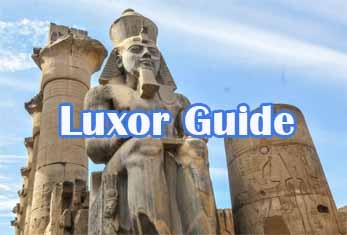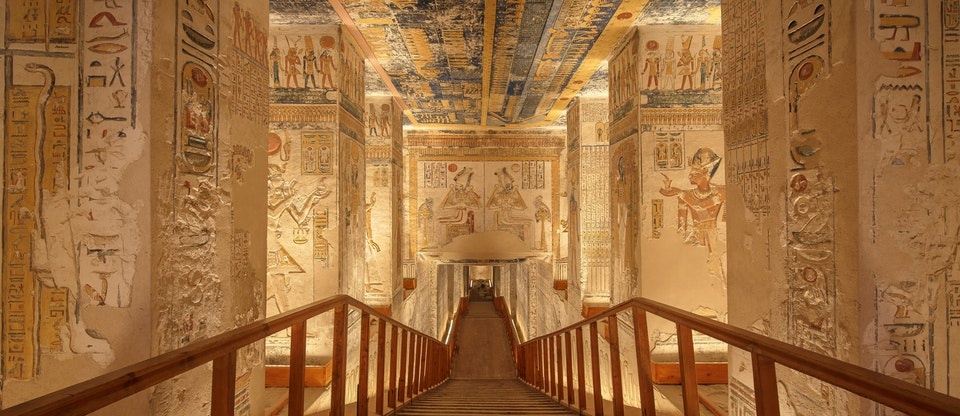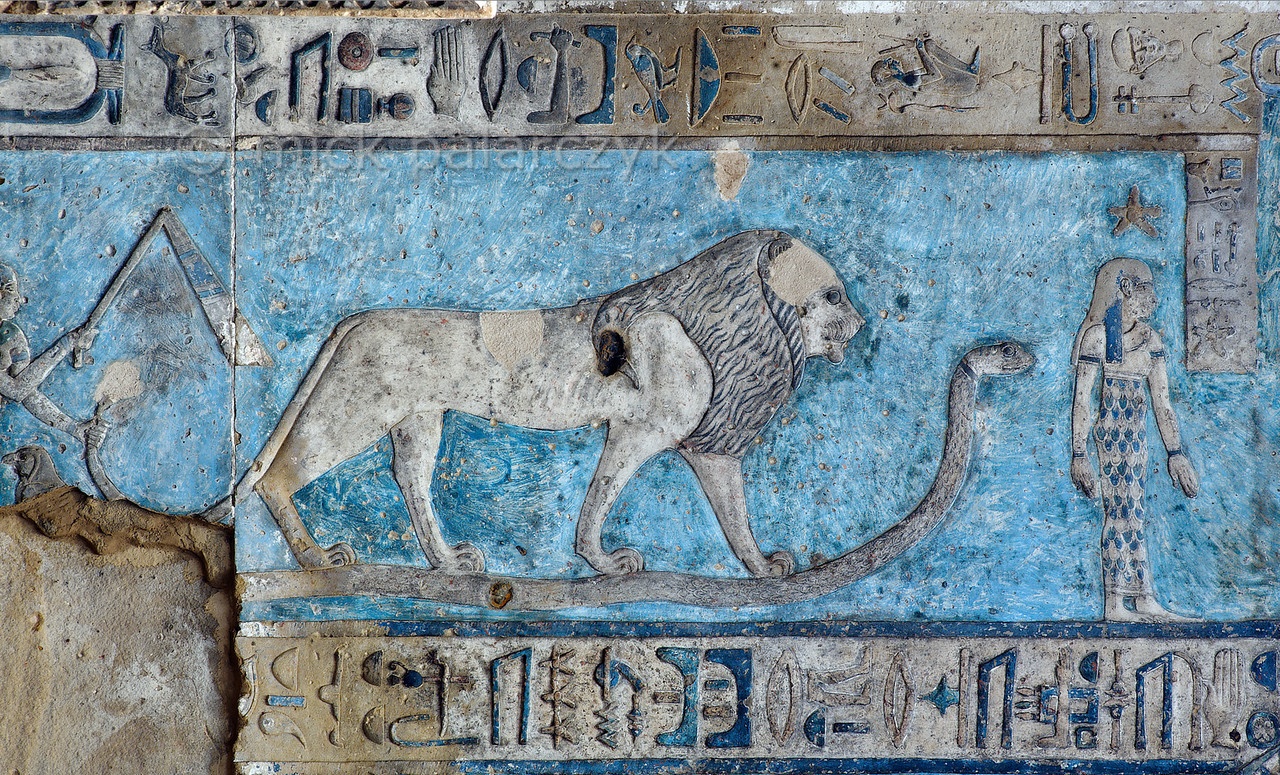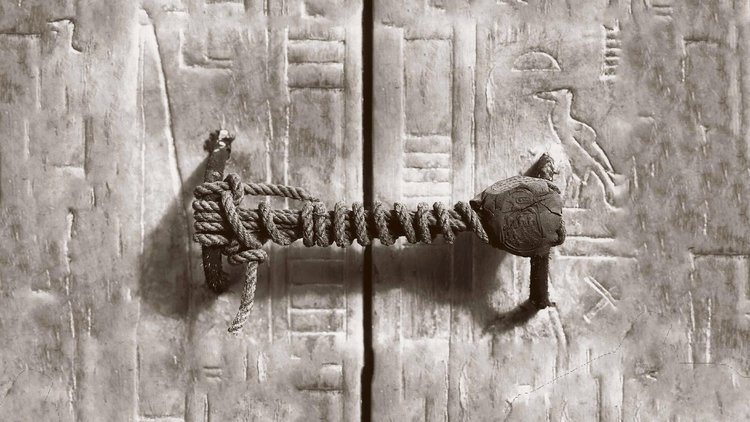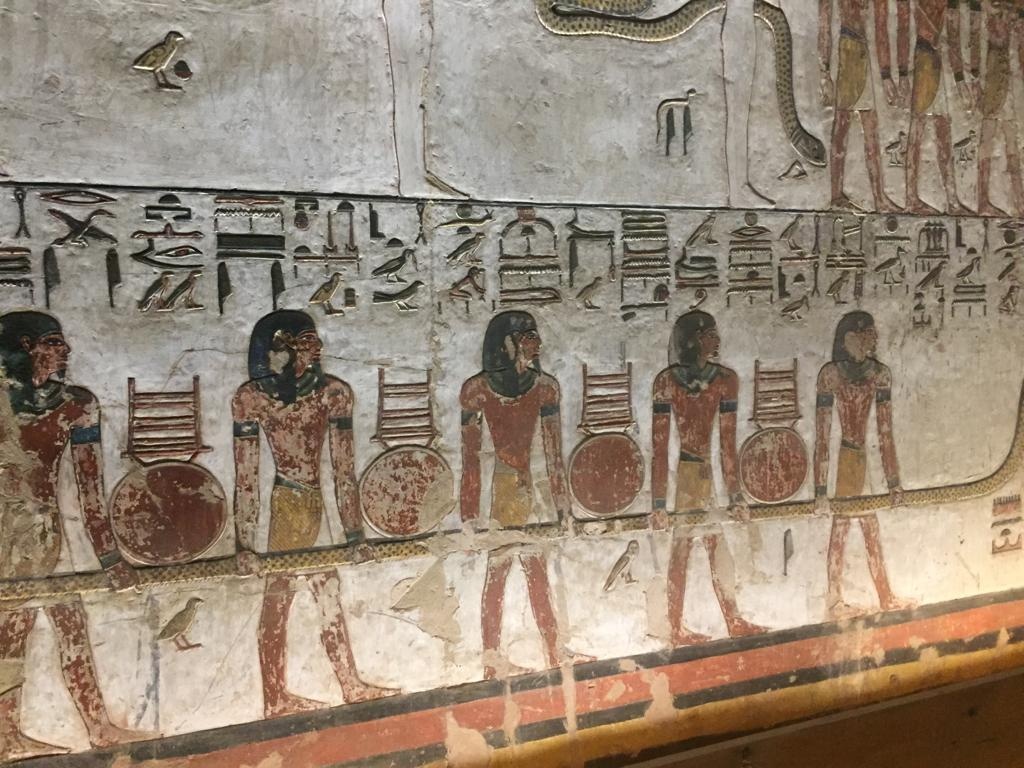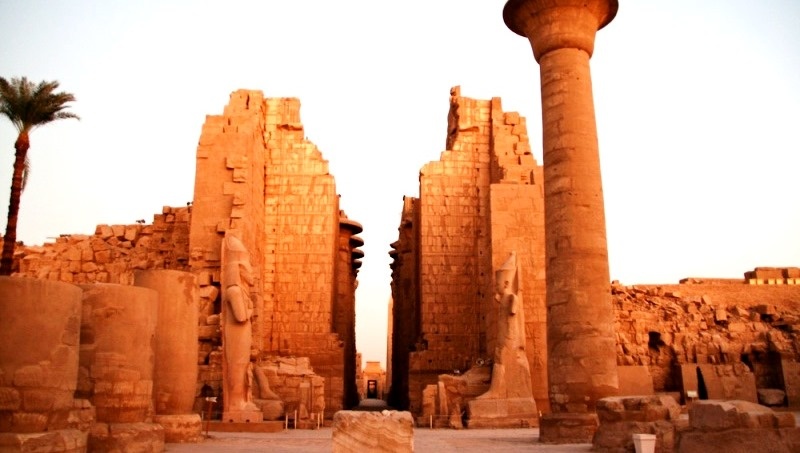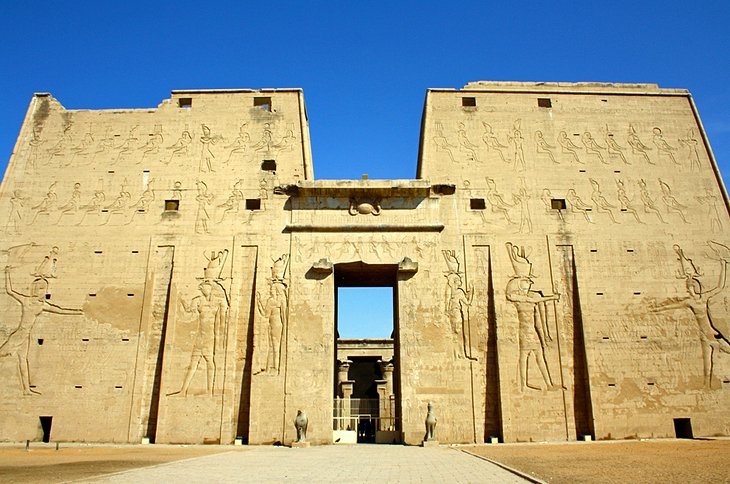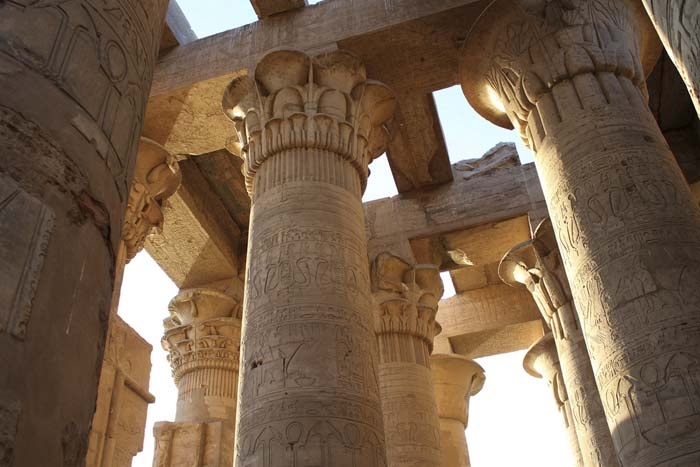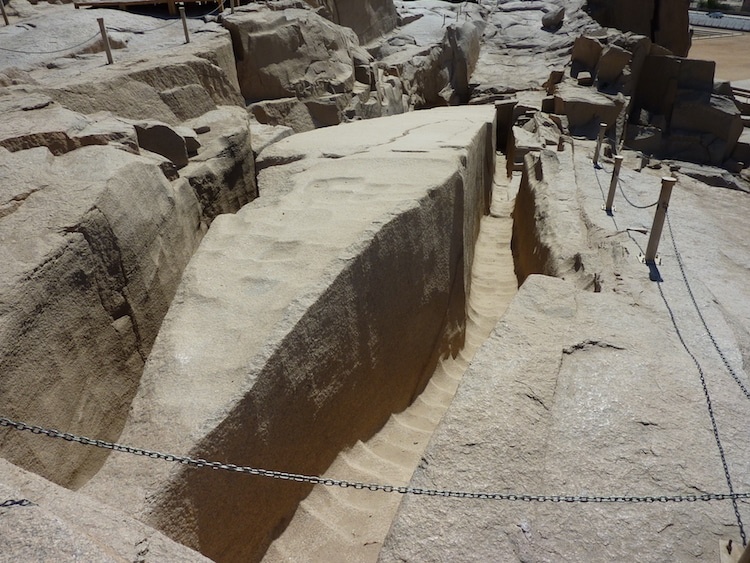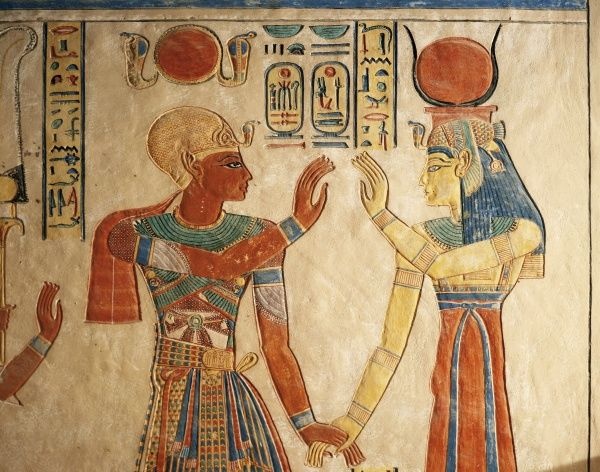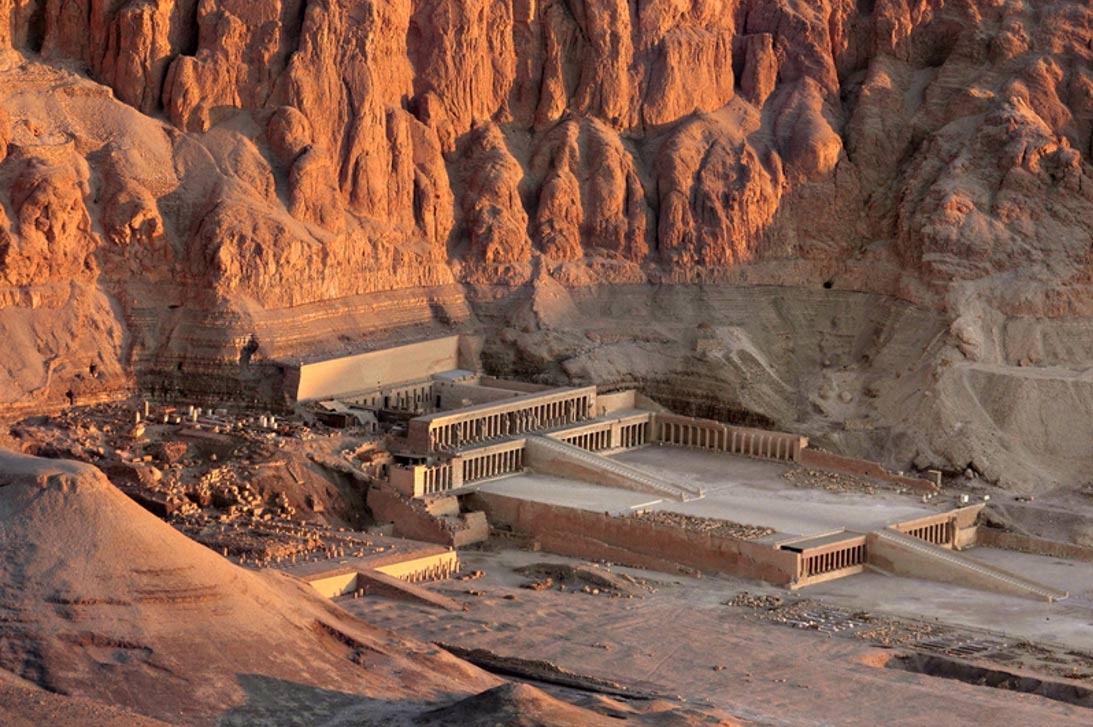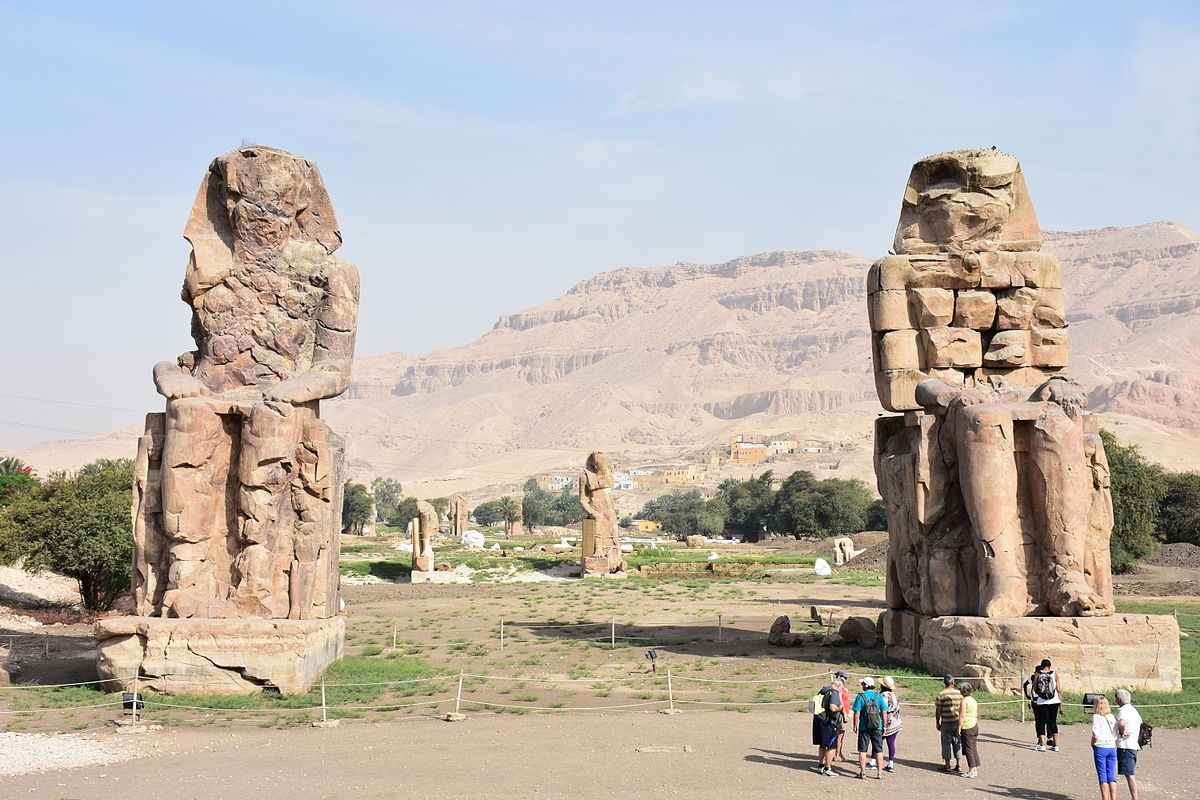luxor Reisgids
Luxor is een stad met veel namen. De oude Egyptenaren noemden het West, wat de stad van de scepter betekent. Toen de Grieken kwamen, noemden ze het Thebe. Tegenwoordig is het de moderne stad Luxor, van het Arabische al-ʾuqṣur (الأقصر) wat "de paleizen" betekent. Deze betoverende stad ligt direct aan de grote Nijl
luxor Reisgids
Luxor
is a city of many names. The ancient Egyptians called it Waset, meaning the City of the Sceptre. When the Greeks came, they called it Thebes. Today it is the modern city of Luxor
, from the Arabic al-ʾuqṣur (الأقصر) meaning "the palaces". This enchanting city is located right along the great Nile River, about 500 kilometres south of the modern Egyptian capital, Cairo
.
Luxor is the best place to learn about ancient Egypt. Walking along the ruins is like stepping back 3,000 years in time.
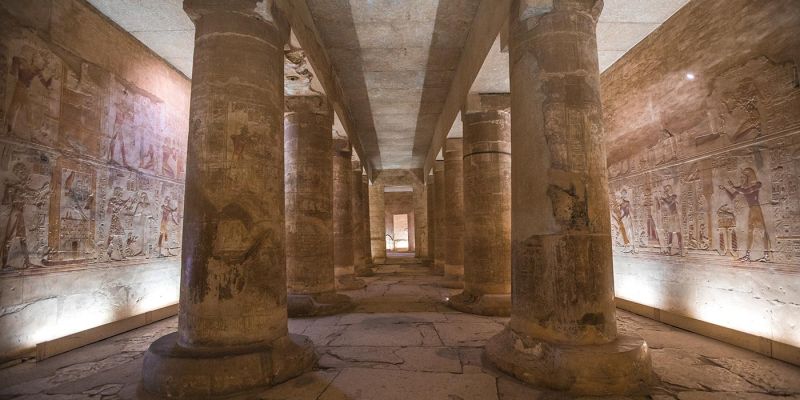 Modern Day Luxor
:
Modern Day Luxor
:
Today, Luxor has been given the nickname, “the world’s greatest open-air museum”. This is thanks to the ancient pharaohs’ efforts to immortalize themselves. Both sides of the Nile are covered in the remains of temples and funerary complexes. The modern city was built up right along with these ruins. It creates an interesting mix of old and new that can only be found in Luxor . This is most evident in the areas of Luxor Temple and Karnak Temple Complex. Their ancient stone architecture sits next to sleek modern construction, creating a beautiful contrast.
Additionally, the area around Luxor and the opposite bank of the river are dotted with a wealth of other temples and tombs. It would several days to explore all of the archaeological sites in the area. At each site sits a wealth of knowledge about the ancient Egyptians and their world.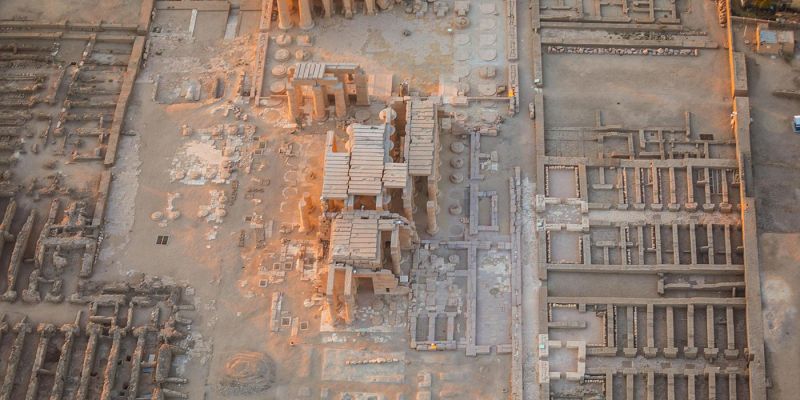 It is easiest to divide the sites around Luxor
into two categories—those on the East Bank of the Nile and those on the West Bank. This division would have suited the ancient Egyptians as well since to them the East Bank was the land of the living, where the sun rose and people thrived, and the West Bank was the land of the dead, where the sunset and people journeyed into the afterlife. Luxor
and the remains of ancient Thebes are located on the East Bank along with the temple complexes that were used to observe the ancient religion in life. The sites on the West Bank are tombs and funerary temples, where Ancient Egyptians and their rulers were laid to rest begin their journey into the afterlife.
Luxor
Travel Guide
It is easiest to divide the sites around Luxor
into two categories—those on the East Bank of the Nile and those on the West Bank. This division would have suited the ancient Egyptians as well since to them the East Bank was the land of the living, where the sun rose and people thrived, and the West Bank was the land of the dead, where the sunset and people journeyed into the afterlife. Luxor
and the remains of ancient Thebes are located on the East Bank along with the temple complexes that were used to observe the ancient religion in life. The sites on the West Bank are tombs and funerary temples, where Ancient Egyptians and their rulers were laid to rest begin their journey into the afterlife.
Luxor
Travel Guide
Things to do:
It would take weeks to experience everything that Luxor has to offer. So what should you do? Here are a few recommendations to make sure you catch all of the highlights of Luxor .
One of the most unique experiences in Luxor taking a hot air balloon ride at sunrise over the city. See for yourself why Luxor is the world’s greatest open-air museum. It is also a great introduction to all of the things you can see in Luxor . The bird’s-eye view allows you to see an impressive size and significant planning that went into the complexes. The early morning light only adds to this stunning experience. It turns the temples beautiful colors as the light rises and intensifies in the east.
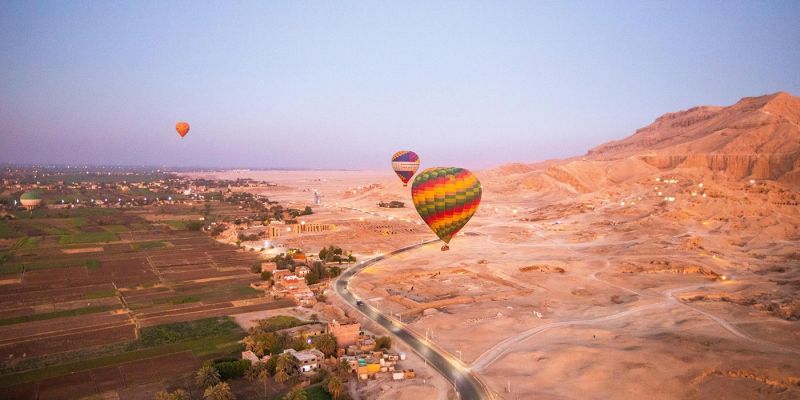 Next, go see these amazing ruins up close! Take a tour of east and west bank. We recommend spending a full day on each side. The main sites on the east bank are Karnak
and Luxor
Temples, dedicated to the god Amon, his wife, Mut, and their son Khonso. The west bank includes the Valley of the Kings, the Colossi of Memnon
, and Hatshepsut
Temple. The Valley of the Kings is where Howard Carter famously found King Tut’s unopened tomb. The Colossi of Memnon
are two gigantic 59-foot statues of Pharaoh Amenhotep III and his wife. They were made famous in antiquity by a mysterious sound emitted from one of them each sunrise.
Next, go see these amazing ruins up close! Take a tour of east and west bank. We recommend spending a full day on each side. The main sites on the east bank are Karnak
and Luxor
Temples, dedicated to the god Amon, his wife, Mut, and their son Khonso. The west bank includes the Valley of the Kings, the Colossi of Memnon
, and Hatshepsut
Temple. The Valley of the Kings is where Howard Carter famously found King Tut’s unopened tomb. The Colossi of Memnon
are two gigantic 59-foot statues of Pharaoh Amenhotep III and his wife. They were made famous in antiquity by a mysterious sound emitted from one of them each sunrise.
The Sound and Light Show at Karnak Temple is something really special. After sunset, the temple illuminated with an audio-visual show that explains how the temple was built and what life was like in ancient Egypt. The visual effects seem to bring the Temple back to life.
You can’t leave Luxor without taking a day trip to Dendera and Abydos. These are two of the best-preserved and most complete temples from ancient Egypt. Full colour is still visible on the walls of these beautiful temples. Abydos is the burial location of the ancient god of the underworld. The temple was built by King Seti I, and completed by King Ramsess II. Dendera is a temple dedicated to Hathor, the Egyptian goddess of love and joy.










Luxor is the best place to learn about ancient Egypt. Walking along the ruins is like stepping back 3,000 years in time.
 Modern Day Luxor
:
Modern Day Luxor
:Today, Luxor has been given the nickname, “the world’s greatest open-air museum”. This is thanks to the ancient pharaohs’ efforts to immortalize themselves. Both sides of the Nile are covered in the remains of temples and funerary complexes. The modern city was built up right along with these ruins. It creates an interesting mix of old and new that can only be found in Luxor . This is most evident in the areas of Luxor Temple and Karnak Temple Complex. Their ancient stone architecture sits next to sleek modern construction, creating a beautiful contrast.
Additionally, the area around Luxor and the opposite bank of the river are dotted with a wealth of other temples and tombs. It would several days to explore all of the archaeological sites in the area. At each site sits a wealth of knowledge about the ancient Egyptians and their world.
 It is easiest to divide the sites around Luxor
into two categories—those on the East Bank of the Nile and those on the West Bank. This division would have suited the ancient Egyptians as well since to them the East Bank was the land of the living, where the sun rose and people thrived, and the West Bank was the land of the dead, where the sunset and people journeyed into the afterlife. Luxor
and the remains of ancient Thebes are located on the East Bank along with the temple complexes that were used to observe the ancient religion in life. The sites on the West Bank are tombs and funerary temples, where Ancient Egyptians and their rulers were laid to rest begin their journey into the afterlife.
Luxor
Travel Guide
It is easiest to divide the sites around Luxor
into two categories—those on the East Bank of the Nile and those on the West Bank. This division would have suited the ancient Egyptians as well since to them the East Bank was the land of the living, where the sun rose and people thrived, and the West Bank was the land of the dead, where the sunset and people journeyed into the afterlife. Luxor
and the remains of ancient Thebes are located on the East Bank along with the temple complexes that were used to observe the ancient religion in life. The sites on the West Bank are tombs and funerary temples, where Ancient Egyptians and their rulers were laid to rest begin their journey into the afterlife.
Luxor
Travel GuideThings to do:
It would take weeks to experience everything that Luxor has to offer. So what should you do? Here are a few recommendations to make sure you catch all of the highlights of Luxor .
One of the most unique experiences in Luxor taking a hot air balloon ride at sunrise over the city. See for yourself why Luxor is the world’s greatest open-air museum. It is also a great introduction to all of the things you can see in Luxor . The bird’s-eye view allows you to see an impressive size and significant planning that went into the complexes. The early morning light only adds to this stunning experience. It turns the temples beautiful colors as the light rises and intensifies in the east.
 Next, go see these amazing ruins up close! Take a tour of east and west bank. We recommend spending a full day on each side. The main sites on the east bank are Karnak
and Luxor
Temples, dedicated to the god Amon, his wife, Mut, and their son Khonso. The west bank includes the Valley of the Kings, the Colossi of Memnon
, and Hatshepsut
Temple. The Valley of the Kings is where Howard Carter famously found King Tut’s unopened tomb. The Colossi of Memnon
are two gigantic 59-foot statues of Pharaoh Amenhotep III and his wife. They were made famous in antiquity by a mysterious sound emitted from one of them each sunrise.
Next, go see these amazing ruins up close! Take a tour of east and west bank. We recommend spending a full day on each side. The main sites on the east bank are Karnak
and Luxor
Temples, dedicated to the god Amon, his wife, Mut, and their son Khonso. The west bank includes the Valley of the Kings, the Colossi of Memnon
, and Hatshepsut
Temple. The Valley of the Kings is where Howard Carter famously found King Tut’s unopened tomb. The Colossi of Memnon
are two gigantic 59-foot statues of Pharaoh Amenhotep III and his wife. They were made famous in antiquity by a mysterious sound emitted from one of them each sunrise.The Sound and Light Show at Karnak Temple is something really special. After sunset, the temple illuminated with an audio-visual show that explains how the temple was built and what life was like in ancient Egypt. The visual effects seem to bring the Temple back to life.
You can’t leave Luxor without taking a day trip to Dendera and Abydos. These are two of the best-preserved and most complete temples from ancient Egypt. Full colour is still visible on the walls of these beautiful temples. Abydos is the burial location of the ancient god of the underworld. The temple was built by King Seti I, and completed by King Ramsess II. Dendera is a temple dedicated to Hathor, the Egyptian goddess of love and joy.
1- KARNAK TEMPLE
Of all Luxor 's many monuments, the Temple Complex of Karnak has to be its most astonishing and beautiful feat. Within its precincts are the Great Temple of Amun, the Temple of Khons, and the Festival Temple of Tuthmosis III, as well as many other buildings. It is not built to a single unified plan but represents the building activity of many successive rulers of Egypt, who vied with one another in adding to and adorning this great national sanctuary, which became the most important of Egypt's temples during the New Kingdom. All the monuments here are on a gigantic scale, reducing visitors to ant-like proportions as they gaze up at mighty columns and colossal statuary. Even if you're short on time, don't scrimp on your visit here. You need at least three hours to try and make sense of the entire complex. You can easily walk to Karnak from downtown along the Nile-side Corniche road, although due to the heat, most people take a taxi. If you're short on time, plenty of tours are offered that whip you around the highlights of Karnak . A private tour of Luxor East Bank, Karnak , and the Luxor temples is a good option. This half-day tour visits these ancient sites with an Egyptologist.
2. VALLEY OF THE KINGS
The famed Valley of the Kings, hidden between rocky escarpments, was the final resting place for the kings of the 18th, 19th, and 20th dynasties. Their main attraction is their wonderfully vivid wall paintings. Since it was believed that the dead man, accompanied by the sun god (or perhaps having become one with the sun god) sailed through the underworld at night in a boat, the walls of the tombs were adorned with texts and scenes depicting this voyage and giving the dead man instruction on its course. Within the valley are 63 tombs, which are a roll-call of famous names of Egyptian history, including the famous boy-king Tutankhamun. The tombs are open on a rotation system to preserve the paintings as much as possible from the damage caused by humidity.
3. LUXOR TEMPLE
Presiding over the modern downtown district, Luxor Temple is an ode to the changing face of Egypt through the centuries. Built first by Amenophis III (on the site of an earlier sandstone temple), it was known as "the southern harem of Amun" and was dedicated to Amun, his consort Mut, and their son the moon god Khons. Like all Egyptian temples, it comprises the chapels of the deities with their vestibules and subsidiary chambers, a large Hypostyle Hall, and an open Peristyle Court, which was approached from the north by a great colonnade.The temple was added to and changed by a parade of pharaohs, including Amenophis IV (who obliterated all references to the god Amun within the temple and added the Sanctuary of the god Aten), Tutankhamun (who had the walls of the colonnade embellished with reliefs and in turn destroyed the Temple of the Aten), Seti I (who restored the reliefs of Amun), and Ramses II (who extended the temple significantly, adding a new colonnaded court at the north end). During the Christian era, the temple underwent a transformation into a church, while in the Islamic period, the Mosque of Abu el-Haggag, dedicated to a revered holy man, was built inside the complex grounds.
4. TEMPLE OF DEIR AL-BAHRI (QUEEN HATSHEPSUT'S TEMPLE)
The Temple of Deir el-Bahri is magnificently situated at the foot of the sheer cliffs fringing the desert hills, the light-colored, almost white, sandstone of the temple standing out prominently against the golden yellow to light brown rocks behind. The temple complex is laid out on three terraces rising from the plain, linked by ramps, which divide it into a northern and a southern half. Along the west side of each terrace is a raised colonnade.The terraces were hewn out of the eastern slopes of the hills, with retaining walls of the finest sandstone along the sides and to the rear. The temple itself was also partly hewn from the rock. Inside, the complex is richly adorned with statues, reliefs, and inscriptions. Note how Queen Hatshepsut had herself represented with the attributes of a male pharaoh (beard and short apron) to demonstrate that she possessed all the authority of a king.
5. LUXOR MUSEUM
One of Egypt's best museums, Luxor Museum holds a beautifully exhibited collection from the local area, which tells the story of ancient Thebes from the Old Kingdom right up to the Islamic Period. The museum's prize possessions are the two Royal Mummies of Ahmose I and what is believed to be Ramses I in two rooms on the ground floor, which are worth a visit here alone. The upper floor has a dazzling display of amulets, silver bowls, grave and tomb furnishings, and votive tablets running across the middle of the floor space. While here, check out the reliefs on the re-erected Wall of Akhenaten. The 283 sandstone blocks are covered with painted reliefs and originally belonged to Akhenaten's Temple of the Sun at Karnak .
6. MEDINET HABU
With the famous Valley of the Kings and Temple of Deir al-Bahri the main attractions, Medinet Habu often gets overlooked on a West Bank trip, but this is one of Egypt's most beautifully decorated temples and should be on everyone's West Bank hit list. The complex consists of a small, older temple built during the 18th dynasty and enlarged in the Late Period, and the great Temple of Ramses III, associated with a royal palace, which was surrounded by a battlemented enclosure wall four meters high. The main temple area was built exactly on the model of the Ramesseum and, like the Ramesseum, was dedicated to Amun. The reliefs here are some of the best you'll see on the West Bank.
7. TOMBS OF THE NOBLES
If you haven't had your fill of tombs in the Valley of the Kings then make a beeline for the Tombs of the Nobles, which may be less famous, but actually include much better preserved examples of tomb paintings. The site contains around 400 tombs of various dignitaries, which date roughly from the 6th dynasty right up to the Ptolemaic era. The tomb paintings here aren't so concerned with guiding the dead into the afterlife; instead they showcase scenes from Egyptian daily life. In particular the Tomb of Sennofer, Tomb of Rekhmire, Tomb of Khonsu, Tomb of Benia, Tomb of Menna, and Tomb of Nakht are home to some of Egypt's most vivid and lively tomb paintings. If you're short of time, opt to see the Tomb of Sennofer and Tomb of Rekhmire. Both have incredibly detailed paintings depicting scenes from the men's daily lives, work, and family life. Sennofer was an overseer during the reign of Amenhotep II, while Rekhmire was the pharaoh's vizier.
8. COLOSSI OF MEMNON
Beside the road that runs from the Valley of the Queens and Medinet Habu towards the Nile are the famous gigantic statues known as the Colossi of Memnon . Carved out of hard yellowish-brown sandstone quarried in the hills above Edfu, they represent Amenophis III seated on a cube-shaped throne, and once stood guard at the entrance to the king's temple, of which only scanty traces are left. In Roman Imperial times they were taken for statues of Memnon , son of Eos and Tithonus, who was killed by Achilles during the Trojan War. The South Colossus is better preserved than the one to the north. It stands 19.59-meters high and the base is partly buried under the sand. With the crown that it originally wore but has long since vanished, the total height must have been some 21 meters. The North Colossus is the famous "musical statue," which brought flocks of visitors here during the Roman Imperial period. Visitors observed that the statue emitted a musical note at sunrise and this gave rise to the myth that Memnon was greeting his mother, Eos, with this soft, plaintive note. The sound ceased to be heard after Emperor Septimus Severus had the upper part of the statue restored. If you walk behind the statues, you can see the vast site (currently being excavated by archaeologists) where Amenophis III's temple once sat.
9 . RAMESSEUM
The great mortuary temple built by Ramses II and dedicated to Amun, lies on the edge of the cultivated land, some one-and-a-half kilometers south of Deir el-Bahri. Although only about half of the original structure survives, it is still a highly impressive monument. During the Roman Imperial period, it was known as the Tomb of Ozymandias, mentioned by the historian Diodorus (1st century BC) and was later immortalized by the English poet Shelley in his poem Ozymandias. The north tower and south tower are inscribed with reliefs of Ramses II's battle with the Hittites, similar to the reliefs of Abu Simbel. On the South Tower, the whole of the left hand half of the wall is taken up by the Battle of Qadesh. Scenes here portray Ramses in his chariot dashing against the Hittites, who are killed by his arrows or flee in wild confusion and fall into the River Orontes, while to the right, you can make out the Hittite Prince and the enemy fleeing into their fortress. Inside the First Court are the remains of a colossal figure of the king, which is estimated to have originally had a total height of 17.5 meters and to have weighed more than 1,000 tons.
10. VALLEY OF THE QUEENS
The tombs in the Valley of the Queens mostly belong to the 19th and 20th dynasties. A total of almost 80 tombs are now known, most of them excavated by an Italian expedition led by E. Schiaparelli between 1903 and 1905. Many of the tombs are unfinished and without decoration, resembling mere caves in the rocks. There are few incised inscriptions or reliefs, with much of the decoration consisting of paintings on stucco.Only four tombs are open for public viewing, but one of the group is the famed Tomb of Queen Nefertari, only reopened in 2016, making a trip here well worth it. The Tomb of Queen Nefertari, Wife to Ramses II, is regarded as the finest of the West Bank's glut of tombs. The walls and ceilings of the chambers here are covered with dazzling, highly detailed and richly colored scenes, which celebrate Nefertari's legendary beauty. Of the three other tombs that can be seen here, the Tomb of Prince Amen-her-khopshef is the best, as the wall paintings of its chambers have well-preserved colors. A son of Ramses III, Amen-her-khopshef died while still a teenager. If you have time, or simply just like tombs, the Tomb of Khaemwaset (another son of Ramses III) and the Tomb of Queen Titi both contain some interesting preserved scenes, though those in the Titi tomb are more faded than Khaemwaset. There is no consensus in the archaeology world over who Titi's husband was.

